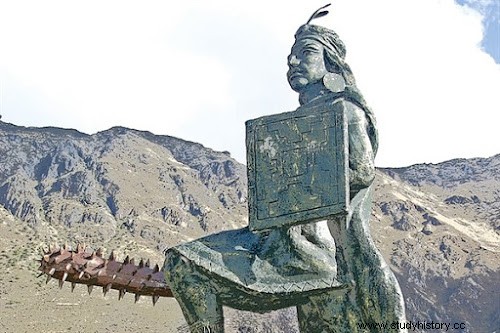Manco Inca promoted Diego de Almagro's trip to Chile to separate him from his partner and annihilate him. The story of the long resistance of the Incas against the Spanish, initiated by Manco Inca, appointed by the Spanish as Atahualpa's successor; and continued by three of his sons, is full of historical passages little known or ignored by some of our historians. One of those passages was the role played by Huáscar Túpac Paullu Inkil (or Cristóbal Paullu Inca), named Inca by Diego de Almagro, the Old Man. Let us remember this story, which is part of the long struggle undertaken by the successors of Atahualpa from 1536.

After the execution of Atahualpa, Francisco Pizarro named Túpac Hualpa, called Toparpa, Inca, who died three months into his term (August to October 1533) due to a poisoning attributed to General Calcuchimac, who was sentenced to death for it. To succeed him on the throne, Manco Inca Yupanqui (also called Manco Cápac II) was appointed ), half-brother of Huáscar and Atahualpa, who would rebel against the Spanish and start a war that would initially last eight years. When starting the war to reconquer his empire, Manco Inca promoted Diego de Almagro's trip to Chile in search of new riches . The monarch's intention was to physically separate him from his conquering partner and annihilate him during his journey south. With that in mind, he sent Vila Oma, high priest and general of his armies, to direct the operation and the interpreter Felipillo as the main conspirator. (The role that he fulfilled on that occasion allowed him to claim himself as a hero, as we remember in the chronicles published on October 27 and November 10, 2018.)
The plan was frustrated by the decision of Prince Paullu Inca –in command of a large contingent of Indians– to accompany Almagro to make merits before the Spaniards, exalt himself and be recognized as an Inca under their aegis. Paullu was Manco's half brother and son of Huáscar and Añas Colque, and he believed with the right to succeed him in the government, which was denied him because he was the son of a provincial princess and could not belong to his father's panaca. However, the imperial order having been destroyed, the princes of provincial mothers had come to consider themselves with equal rights as those of the closed caste of the orejones. Late, Manco Inca found out about his half-brother's wicked behavior and his servile approach to Almagro, and he could do nothing to contain it.
Paullu's presence prevented the natives from attacking the invaders, and there is a version that he refused to carry out the massacre, arguing that, with the escape from Copiapó, he did not have enough men left to carry out the order. had retreated to Vilcabamba–, and that the city was governed by Hernando and Gonzalo Pizarro. With the help of Paullu, the frustrated conqueror confronted and captured the brothers, and later defeated the troops of Alonso de Alvarado sent by Francisco Pizarro, in the battle of the Abancay Bridge (July 12, 1537), and regained control of Cusco.
After that episode, a grateful Almagro crowned Paullu as Inca, in a lavish ceremony.The Inca's luck would change when Almagro was e defeated in the Battle of Las Salinas (April 6, 1538) and the Pizarros would resume absolute control of the situation. Paullu took refuge to avoid reprisals from the victors.However, Hernando Pizarro, fearing that he would join his brother in Vilcabamba, convinced him to support the Spanish.
This is what the false Inca did. He turned the Indians loyal to him against his half-brother and his race-brothers. With his help, the Hispanics occupied the citadel of Vilcabamba and defeated the troops of Manco Inca, although they were unable to capture him. Informed of the fact, King Felipe II instructed the lawyer Cristóbal Vaca de Castro to return to Paullu Inca the lands he owned. they were confiscated in Arequipa. Furthermore, Pizarro and Vaca de Castro granted him vast repartimientos, and the Spanish crown granted him a coat of arms in 1544, ennobling him. Finally, he adopted Spanish customs and was baptized with the name of Cristóbal, in 1545, along with his mother. , his sister, his wife, Catalina Tocto Sisa, and an 8-year-old son, in a ceremony sponsored by Garcilaso de la Vega, father of the homonymous chronicler. He lived and 'ruled' in Cusco until the day of his death, in 1549 .
